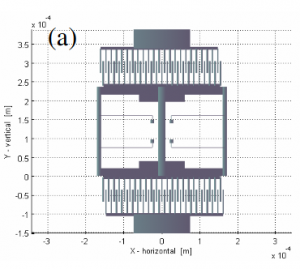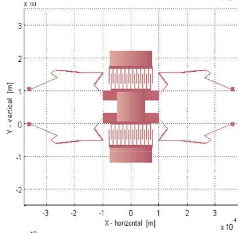2010 |
|
 | Cobb, Corie L; Agogino, Alice M Case-Based Reasoning for Evolutionary MEMS Design Journal Article In: Journal of Computing and Information Science in Engineering, vol. 10, no. 3, pp. 031005, 2010, ISSN: 1530-9827. Abstract | Links | Tags: case-based reasoning, design synthesis, evolutionary algorithms, MEMS, optimization @article{cobb_case-based_2010,A knowledge-based computer-aided design tool for microelectromechanical systems (MEMS) design synthesis called case-based synthesis of MEMS (CaSyn-MEMS) has been developed. MEMS-based technologies have the potential to revolutionize many consumer products and to create new market opportunities in areas such as biotechnology, aerospace, and data communications. However, the commercialization of MEMS still faces many challenges due to a lack of efficient computer-aided design tools that can assist designers during the early conceptual phases of the design process. CaSyn-MEMS combines a case-based reasoning (CBR) algorithm and a MEMS case library with parametric optimization and a multi-objective genetic algorithm (MOGA) to synthesize new MEMS design topologies that meet or improve upon a designer’s specifications. CBR is an artificial intelligence methodology that uses past design solutions and adapts them to solve current problems. Having the ability to draw upon past design knowledge is advantageous to MEMS designers, allowing reuse and modification of previously successful designs to accelerate the design process. To enable knowledge reuse, a hierarchical MEMS case library has been created. A reasoning algorithm retrieves cases with solved problems similar to the current design problem. Focusing on resonators as a case study, case retrieval demonstrated an 82% success rate. Using the retrieved cases, approximate design solutions were proposed by first adapting cases with parametric optimization, resulting in a 25% reduction in design area on average while bringing designs within 2% of the frequency goal. In situations where parametric optimization was not sufficient, a more radical design adaptation was performed through the use of MOGA. CBR provided MOGA with good starting points for optimization, allowing efficient convergence to higher quantities of Pareto optimal design concepts while reducing design area by up to 43% and meeting frequency goals within 5%. |
2008 |
|
 | Cobb, Corie Lynn Case-based reasoning for MEMS design synthesis PhD Thesis University of California, Berkeley, 2008. Links | Tags: case-based reasoning, design synthesis, evolutionary algorithms, MEMS, optimization @phdthesis{cobb_case-based_2008, |
 | Cobb, Corie L; Zhang, Ying; Agogino, Alice M; Mangold, Jennifer Knowledge-Based Evolutionary Linkage in MEMS Design Synthesis Book Chapter In: Linkage in Evolutionary Computation, vol. 157, pp. 461–483, Springer, Berlin, Heidelberg, 2008, ISBN: 978-3-540-85067-0 978-3-540-85068-7. Abstract | Links | Tags: case-based reasoning, design synthesis, evolutionary algorithms, MEMS, optimization @inbook{cobb_knowledge-based_2008,Multi-objective Genetic Algorithms (MOGA) and Case-based Reasoning (CBR) have proven successful in the design of MEMS (Micro-electro-mechanical Systems) suspension systems. This work focuses on CBR, a knowledge-based algorithm, and MOGA to examine how biological analogs that exist between our evolutionary system and nature can be leveraged to produce new promising MEMS designs. Object-oriented data structures of primitive and complex genetic algorithm (GA) elements, using a component-based genotype representation, have been developed to restrict genetic operations to produce feasible design combinations as required by physical limitations or practical constraints. Through the utilization of this data structure, virtual linkage between genes and chromosomes are coded into the properties of pre-defined GA objects. The design challenge involves selecting the right primitive elements, associated data structures, and linkage information that promise to produce the best gene pool for new functional requirements. Our MEMS synthesis framework, with the integration of MOGA and CBR algorithms, deals with the linkage problem by integrating a component-based genotype representation with a CBR automated knowledge-base inspired by biomimetic ontology. Biomimetics is proposed as a means to examine and classify functional requirements so that case-based reasoning algorithms can be used to map design requirements to promising initial conceptual designs and appropriate GA primitives. CBR provides MOGA with good linkage information through past MEMS design cases while MOGA inherits that linkage information through our component-bsased genotype representation. A MEMS resonator test case is used to demonstrate this methodology. |
2007 |
|
 | Cobb, Corie L; Zhang, Ying; Agogino, Alice M; Mangold, Jennifer Case-based reasoning and object-oriented data structures exploit biological analogs to generate virtual evolutionary linkages Proceedings Article In: 2007 IEEE Congress on Evolutionary Computation, pp. 334–341, IEEE, 2007. Abstract | Links | Tags: case-based reasoning, design synthesis, evolutionary algorithms, MEMS, optimization @inproceedings{cobb_case-based_2007,Multiobjective genetic algorithms (MOGA) and case-based reasoning (CBR) have proven successful in the design of MEMS (microelectromechanical systems) suspension systems. Object-oriented data structures of primitive and complex genetic algorithm (GA) elements have been developed to restrict genetic operations to produce feasible design combinations as required by physical limitations or practical constraints. Thus, virtual linkage between genes and chromosomes are coded into the properties of pre-defined GA objects. A new design problem requires selecting the right primitive elements, associated data structures, and linkages that promise to produce the best gene pool for new functional requirements. In this paper, biomimetics is proposed as a means to examine and classify functional requirements so that case-based reasoning algorithms can be used to map design requirements to promising initial conceptual designs and appropriate GA primitives. The concept is demonstrated using micro-mechanical resonators. |
 | Cobb, Corie L; Zhang, Ying; Agogino, Alice M MEMS design synthesis: integrating case-based reasoning and multi-objective genetic algorithms Proceedings Article In: Smart Structures, Devices, and Systems III, pp. 641419, International Society for Optics and Photonics, Adelaide, Australia, 2007. Abstract | Links | Tags: case-based reasoning, design synthesis, evolutionary algorithms, MEMS, optimization @inproceedings{cobb_mems_2007,A case-based reasoning (CBR) knowledge base has been incorporated into a Micro-Electro-Mechanical Systems (MEMS) design tool that uses a multi-objective genetic algorithm (MOGA) to synthesize and optimize conceptual designs. CBR utilizes previously successful MEMS designs and sub-assemblies as building blocks stored in an indexed case library, which serves as the knowledge base for the synthesis process. Designs in the case library are represented in a parameterized object-oriented format, incorporating MEMS domain knowledge into the design synthesis loop as well as restrictions for the genetic operations of mutation and crossover for MOGA optimization. Reasoning tools locate cases in the design library with solved problems similar to the current design problem and suggest promising conceptual designs which have the potential to be starting design populations for a MOGA evolutionary optimization process, to further generate more MEMS designs concepts. Surface micro-machined resonators are used as an example to introduce this integrated MEMS design synthesis process. The results of testing on resonator case studies demonstrate how the combination of CBR and MOGA synthesis tools can help increase the number of optimal design concepts presented to MEMS designers. |
2010 |
|
 | Case-Based Reasoning for Evolutionary MEMS Design Journal Article In: Journal of Computing and Information Science in Engineering, vol. 10, no. 3, pp. 031005, 2010, ISSN: 1530-9827. |
2008 |
|
 | Case-based reasoning for MEMS design synthesis PhD Thesis University of California, Berkeley, 2008. |
 | Knowledge-Based Evolutionary Linkage in MEMS Design Synthesis Book Chapter In: Linkage in Evolutionary Computation, vol. 157, pp. 461–483, Springer, Berlin, Heidelberg, 2008, ISBN: 978-3-540-85067-0 978-3-540-85068-7. |
2007 |
|
 | Case-based reasoning and object-oriented data structures exploit biological analogs to generate virtual evolutionary linkages Proceedings Article In: 2007 IEEE Congress on Evolutionary Computation, pp. 334–341, IEEE, 2007. |
 | MEMS design synthesis: integrating case-based reasoning and multi-objective genetic algorithms Proceedings Article In: Smart Structures, Devices, and Systems III, pp. 641419, International Society for Optics and Photonics, Adelaide, Australia, 2007. |

